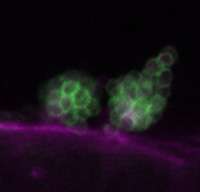Researchers discover early step in blood stem cell development

(Medical Xpress)—University of Wisconsin School of Medicine and Public Health (SMPH) researchers have discovered a very early regulatory event that controls the production of blood stem cells and the adult blood system.
Corrupting the process of stem cell production during development can be lethal at an early stage of an embryo's development, but problems with production during adulthood can yield a variety of diseases like leukemia.
The dorsal aorta, a major blood vessel in a mammalian embryo, is the site where the body's first blood-producing stem cells emerge.
Budding out of the endothelial cells that line the inside of the blood vessel, the adult blood stem cells - those same cells that produce a lifetime of blood - are formed.
A protein known as RUNX-1 allows these hemogenic (hemo- meaning blood, and -genic meaning to produce) endothelial cells to form stem cells. RUNX-1, a regulator of specific genes, is known to promote the production of these stem cells.
The discovery, made in the Bresnick Lab at the Wisconsin Institutes for Medical Research and UW-Madison Blood Research Program, implicates a specific sequence (+9.5) within the GATA-2 gene that elevates the level of the GATA-2 protein, which in turn elevates RUNX-1 and other key regulatory factors in the hemogenic endothelial cells, thus controlling the production of the stem cells.
By genetically deleting the specific +9.5 sequence, stem cell production was halted due to a drop in GATA-2, depriving the embryo of stem cells required to produce blood. In the embryonic mice, the lack of necessary GATA-2 stopped the development of blood stem cells as early as day 10 and was lethal by day 14.
This domino effect of cellular signals could be relatively simple; one protein activates another protein which activates another to eventually generate the stem cells. If so, then reintroducing GATA-2 or RUNX-1, or perhaps other downstream factors, could rescue the process, just as knocking over a domino in the middle of the chain would continue the cascade.
However, Bresnick points out that since "GATA-2 regulates multiple genes required for the stem cell production, one needs to consider how the overall genetic network mediates this critical process, and we are making significant strides in understanding the problem at this level."
Bresnick's group, collaborating with Zhang and Steven Holland at the National Institutes of Health, discovered and described in their 2012 findings the role of the +9.5 sequence in controlling the production of GATA-2 in the liver of a developing mouse embryo, as well as the parallel relationship between the decline in GATA-2 and the decline in stem cells and stem cell progeny in the liver.
"The +9.5 site is essential to generate the stem cells that form adult blood cells," said Bresnick, who is also the director of the UW Blood Research Program. "When this region is corrupted later in life, GATA-2 expression drops, yielding an immunodeficiency as a child or adult. The immunodeficiency commonly progresses to myelodysplastic syndrome and acute myeloid leukemia. Gaining a clear mechanistic insight into how this process is regulated will almost certainly provide new opportunities for targeting blood cancers."
More information: "Gata2 cis-element is required for hematopoietic stem cell generation in the mammalian embryo." Xin Gao, Kirby D. Johnson, Yuan-I Chang, Meghan E. Boyer, Colin N. Dewey, Jing Zhang, Emery H. Bresnick.Journal of Experimental Medicine, December 2, 2013. DOI: 10.1084/jem.20130733
















